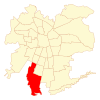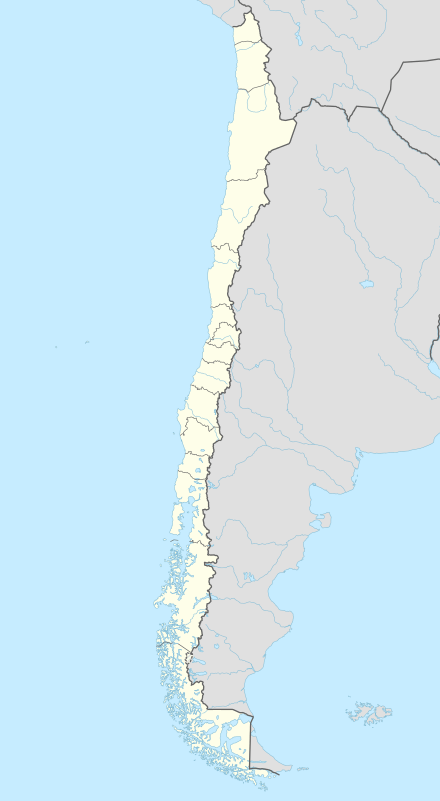San Bernardo, Chile
| San Bernardo | ||||||
|---|---|---|---|---|---|---|
| City and Commune | ||||||
| ||||||
| Coordinates (city): 33°35′S 70°42′W / 33.583°S 70.700°WCoordinates: 33°35′S 70°42′W / 33.583°S 70.700°W | ||||||
| Country | Chile | |||||
| Region | Santiago Metro. | |||||
| Province | Maipo | |||||
| Founded | 1821 | |||||
| Government[1] | ||||||
| • Type | Municipality | |||||
| • Alcalde | Nora Cuevas Contreras (UDI) | |||||
| Area[2] | ||||||
| • Total | 155.1 km2 (59.9 sq mi) | |||||
| Elevation | 570 m (1,870 ft) | |||||
| Population (2002 Census)[2] | ||||||
| • Total | 246,762 | |||||
| • Density | 1,600/km2 (4,100/sq mi) | |||||
| • Urban | 241,138 | |||||
| • Rural | 5,624 | |||||
| Sex[2] | ||||||
| • Men | 121,535 | |||||
| • Women | 125,227 | |||||
| Time zone | CLT [3] (UTC-4) | |||||
| • Summer (DST) | CLST [4] (UTC-3) | |||||
| Area code(s) | +56 | |||||
| Website | Municipality of San Bernardo | |||||
San Bernardo (Spanish pronunciation: [sam berˈnarðo]) is a city of Chile, part of the Greater Santiago conurbation. Administratively, it is a commune and the capital of the Maipo Province in the Santiago Metropolitan Region. It is the seat of the Roman Catholic Diocese of San Bernardo.
Demographics
According to the 2002 census of the National Statistics Institute, San Bernardo spans an area of 155.1 km2 (60 sq mi) and has 246,762 inhabitants (121,535 men and 125,227 women). Of these, 241,138 (97.7%) lived in urban areas and 5,624 (2.3%) in rural areas. The population grew by 29.3% (55,905 persons) between the 1992 and 2002 censuses.[2]
Stats
- Population: 286,228 (2006 projection)[5]
- Average annual household income: US$16,035 (PPP, 2009)[5]
- Population below poverty line: 20.9% (2006)[6]
Administration
As a commune, San Bernardo is a third-level administrative division of Chile administered by a municipal council, headed by an alcalde who is directly elected every four years. The 2012-2016 alcalde is Nora Cuevas Contreras (UDI). The council has the following members:[1]
- Amparo García Saldias (UDI)
- Christopher White Bahamondes (PS)
- Leonel Cadiz Soto (PS)
- Luis Navarro Ormeño (PRSD)
- Orfelina Bustos Carmona (PDC)
- Raimundo Camus Varas (UDI)
- Ricardo Rencoret Klein (UDI)
- Sebastián Tapia Macaya (PDC)
- Sebastián Orrego Cisternas (RN)
- Soledad Perez Peña (IND)
The regional intendant, appointed by the president, is Fernando Echeverría.[7]
Within the electoral divisions of Chile, San Bernardo is represented in the Chamber of Deputies by Ramón Farías (PPD) and Mr. José Antonio Kast (UDI) as part of the 30th electoral district, (together with Buin, Paine and Calera de Tango). The commune is represented in the Senate by Guido Girardi Lavín (PPD) and Jovino Novoa Vásquez (UDI) as part of the 7th senatorial constituency (Santiago-West).
Chilean Folklore Capital
At a national level, San Bernardo is characterized as the capital of Chilean folkloric traditions.[8] This is mainly due to two annual events held in the commune: the “Festival Nacional del Folklore de San Bernardo” (english: San Bernardo’s National Festival of Folklore) and “Abril Cuecas Mil” (english: A Thousand Cuecas April).
Festival Nacional del Folklore
The Festival Nacional del Folklore de San Bernardo has been held at the end of February since 1972 and draws participants and spectators from all around the country. The festival consists performances of traditional and folkloric Chilean music, dance, and singing, as well as competitions held at school, corporate, and community levels. It also features participants from other countries who are invited to showcase their respective folkloric traditions. An additional part of the festivals is the "Feria de Artesanía Tradicional" (english: Traditional Crafts Fair”), which centres around showcasing and promoting traditional artisanal gastronomy, arts and crafts from Chile and other Latin American cultures.[9]
Abril Cuecas Mil
Abril Cuecas Mil is held annually on the last Saturday of April, since 1993. First proposed by professor Arturo García Araneda, a San Bernardino folklorist, the event centres around Cueca, Chile’s national dance. The event lasts for about 30 continuous hours and consists of a line-up of musicians, bands, or folkloric groups playing a thousand Cuecas for an open floor, where anyone is welcomed to partake in the dancing. Participants range from enthusiasts and amateurs to professional and trained dancers. The style of Cueca usually alternates between more traditional folkloric styles during the day (e.g., salon, campesina, etc.) and more risqué styles during the night (e.g., porteña, brava, etc.).[10]
Chena’s Pucará
The Chena hills, located in the basin of San Bernardo, are home to an Incan sacred site known as the Huaca of Chena or Chena’s Pucará.[11] Initially thought to be a fortress, the structure in the southern tip of the Chena hills has been denominated as a huaca (Quechuan Wak'a) a sacred place, a space of ritual use. The Chena’s Pucará was observed to have a zoomorphic design, resembling a puma, which is a characteristic of Incan ceremonial and sacred structures. The word Chena (the name of the hills) means puma in oestrous cycle in the Quechuan language.[12]
Subsequent investigations have further supported the sacred denomination by revealing the structure to be composed of three separate edifications; an outside perimetral wall, a middle perimetral wall and the central enclosure, all which are consistent with Incan architectural tripartition designs. Furthermore, the principle structure’s design is consistent with the structural designs of Incan Ushnu (place of observation). This observatory status has been confirmed by the structure’s seemingly perfect lineation of its altar with the first ray of sun during the winter solstice (June 21st) and the summer solstice (December 21st).[13]
Currently, the commune of San Bernardo lacks the resources to establish proper administration, maintenance, or security of the area, and Chena’s Pucará faces physical abandonment, neglect and banalisation, including dismantling of walls and defecation on the altar. However, in recent years Quechuan and Aymará populations have become interested in negotiating with the authorities for ritualistic and occupation rights in the area.[14]
References
- 1 2 "Municipality of San Bernardo" (in Spanish). Retrieved 3 December 2010.
- 1 2 3 4 "National Statistics Institute" (in Spanish). Retrieved 3 December 2010.
- ↑ "Chile Time". WorldTimeZones.org. Retrieved 26 September 2010.
- ↑ "Chile Summer Time". WorldTimeZones.org. Retrieved 26 September 2010.
- 1 2 Sistema de Información Regional, Ministry of Planning of Chile. Archived April 23, 2008, at the Wayback Machine.
- ↑ "Poverty in the Santiago Metropolitan Region" (PDF). Ministry of Planning of Chile (in Spanish). Archived from the original (PDF) on August 24, 2007.
- ↑ "Gobierno de Chile: Intendentes" (in Spanish). Retrieved 3 December 2010.
- ↑ Departamento Artistico de la Comuna de San Bernardo.(2016). Capital del Folklore Chileno. Retrieved from https://www.sanbernardo.cl/contenidos/capital.folklore/capital.folklore.html
- ↑ Departamento del Festival Nacional del Folklore de San Bernardo.(2016). Festival Nacional del Folklore de San Bernardo. Retrieved from https://www.sanbernardo.cl/contenidos/capital.folklore/capital.folklore.festival.html
- ↑ Departamento Abril Cuecas Mil. (2016). Archivos historicos communales. Retrieved from https://www.sanbernardo.cl/contenidos/archivos-historico-comunal/documentos-mes/04-abril/Abril.pdf
- ↑ Díaz, P. B. (2006). Santiago del Nuevo Extremo ¿Una ciudad sin pasado?. Revista de Diseño Urbano y Paisaje, 3(9), 3-13. Retrieved from http://dup.ucentral.cl/pdf/9_santiago_nuevo_extremo.pdf
- ↑ Díaz, P. B. (2006). Santiago del Nuevo Extremo ¿Una ciudad sin pasado?. Revista de Diseño Urbano y Paisaje, 3(9), 3-13. Retrieved from http://dup.ucentral.cl/pdf/9_santiago_nuevo_extremo.pdf
- ↑ Meddens, F., McEwan, C., & Pomacanchari, C. (2010). Inca “stone ancestors” in context at a high-altitude Usnu platform. Latin American Antiquity, 21(2), 173-194. Retrieved from http://www.academia.edu/8668174/INCA_STONE_ANCESTORS_IN_CONTEXT_AT_A_HIGH-ALTITUDE_USNU_PLATFORM
- ↑ Díaz, P. B. (2006). Santiago del Nuevo Extremo ¿Una ciudad sin pasado?. Revista de Diseño Urbano y Paisaje, 3(9), 3-13. Retrieved from http://dup.ucentral.cl/pdf/9_santiago_nuevo_extremo.pdf
External links
- (Spanish) Municipality of San Bernardo
.svg.png)
.svg.png)


